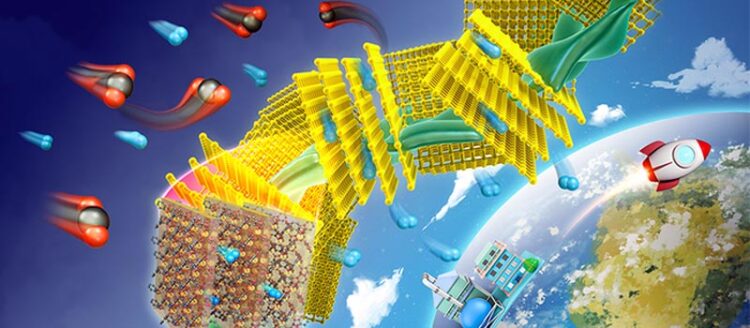New flexible soft-solid MOF composite membrane boosts H2/CO2 separation

A silver bullet for membrane innovation — flexible, defect-free composite membrane sets a new record for MOF membrane series in H2/CO2 separation.
Credit: DICP
Molecular sieve membrane-based separation technology, featured with low energy consumption and small carbon footprint, has attracted much attention in gas separation.
Metal-organic frameworks (MOFs) are promising in gas separation membranes due to their diversified structures, high porosity and tailored functionalities. However, defect-free MOF membrane fabrication still remains challenging.
Recently, a research group led by Prof. YANG Weishen and Dr. PENG Yuan from the Dalian Institute of Chemical Physics (DICP) of the Chinese Academy of Sciences (CAS) has fabricated flexible soft-solid MOF composite membrane on commercial polyvinylidene fluoride (PVDF) substrate.
Within the membrane structure, the quasi-vertically oriented, solid Zn2(Benzimidazolate)4 particles grown on PVDF substrate provided predominant molecular sieving gas entrances while soft polyamide eliminated defects enclosing MOF particles, resulting in better performance in H2/CO2 separation.
This work was published in Angew. Chem. Int. Ed. on Feb. 1.
This robust defect-free composite membrane exhibited an outstanding anti-swelling capacity in condensable feedstock. It showed superior separation accuracies for large C2H6 and C3H8 exclusions.
Moreover, the researchers prepared the Zn2(Bim)4 composite membrane with ultra-high MOF loading and excellent flexibility. After membrane folding and unfolding at 90° for 50 consecutive times or rolling into a tube with a diameter of 3 mm (the largest bending curvature that MOF membranes can endure), the membrane separation performance remained exactly the same.
Soft-solid Zero Insertion Force(ZIF)-67 and ZIF-8 composite membrane series were also fabricated. Taking advantages of defect elimination, the intrinsic molecular sieving capacities of the MOF particles were given full play.
This work was supported by the National Natural Science Foundation of China.
Journal: Angewandte Chemie International Edition
DOI: 10.1002/anie.202117577
Method of Research: Commentary/editorial
Subject of Research: Not applicable
Article Title: Flexible Soft-Solid Metal–Organic Framework Composite Membranes for H2/CO2 Separation
Article Publication Date: 1-Feb-2022
Media Contact
Jean Wang
Dalian Institute of Chemical Physics, Chinese Academy Sciences
wangyj@dicp.ac.cn
Office: 41182464221
All latest news from the category: Life Sciences and Chemistry
Articles and reports from the Life Sciences and chemistry area deal with applied and basic research into modern biology, chemistry and human medicine.
Valuable information can be found on a range of life sciences fields including bacteriology, biochemistry, bionics, bioinformatics, biophysics, biotechnology, genetics, geobotany, human biology, marine biology, microbiology, molecular biology, cellular biology, zoology, bioinorganic chemistry, microchemistry and environmental chemistry.
Newest articles

Bringing bio-inspired robots to life
Nebraska researcher Eric Markvicka gets NSF CAREER Award to pursue manufacture of novel materials for soft robotics and stretchable electronics. Engineers are increasingly eager to develop robots that mimic the…

Bella moths use poison to attract mates
Scientists are closer to finding out how. Pyrrolizidine alkaloids are as bitter and toxic as they are hard to pronounce. They’re produced by several different types of plants and are…

AI tool creates ‘synthetic’ images of cells
…for enhanced microscopy analysis. Observing individual cells through microscopes can reveal a range of important cell biological phenomena that frequently play a role in human diseases, but the process of…





















